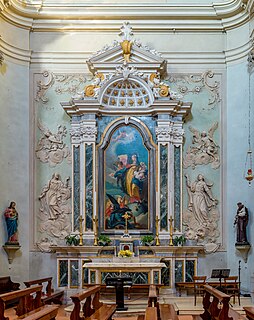Related Research Articles

Illusionistic ceiling painting, which includes the techniques of perspective di sotto in sù and quadratura, is the tradition in Renaissance, Baroque and Rococo art in which trompe-l'œil, perspective tools such as foreshortening, and other spatial effects are used to create the illusion of three-dimensional space on an otherwise two-dimensional or mostly flat ceiling surface above the viewer. It is frequently used to create the illusion of an open sky, such as with the oculus in Andrea Mantegna's Camera degli Sposi, or the illusion of an architectural space such as the cupola, one of Andrea Pozzo's frescoes in Sant'Ignazio, Rome. Illusionistic ceiling painting belongs to the general class of illusionism in art, designed to create accurate representations of reality.

Bartolomeo Nazari was an Italian painter of the late-Baroque, mainly active in Venice as a portraitist.

Tommaso Aldrovandini was an Italian painter of the Baroque period. He mainly painted perspective views and architectural subjects (quadratura), in which the figures were painted by Marcantonio Franceschini and Carlo Cignani. He decorated churches, palaces, and theaters in Forlì, Verona, Venice, Parma, Turin, Ferrara, and Genoa, and especially in his native Bologna. Among his pupils was Giovanni Benedetto Paolazzi.
Rinaldo Botti was an Italian painter active in the Baroque period. He was a pupil of Jacopo Chiavistelli, and specialized in quadratura. He collaborated with Andrea Landini in frescoing some salons of Villas belonging to the Corsini family. He painted the ceiling of Santa Elisabetta delle Convertite.
Pietro Capelli or Pietro Cappelli was an Italian painter of the Rococo, active in his native city of Naples. He trained under Francesco Solimena. He was active in quadratura, but also painted capricci and canvases with landscapes.
Giuseppe Alabardi was an Italian painter, active in Venice around the year 1600. Some works in the Oratory of San Nicola da Tolentino in Vicenza are attributed him. He painted architectural landscapes and quadratura and is recorded as having painted scenery for productions of operas in Venice.
Antonio Pachera was an Italian painter, born in Verona.

Giovanni Battista Innocenzo Colombo was a Swiss painter and stage set designer.
Mauro Aldrovandini (1649–1680) was an Italian painter of the Baroque period. While he was most active in Bologna, and some claim he was native to the city, others claim he was born in Rovigo. He mainly painted perspective views and architectural subjects (quadratura) in private houses and for theaters.
Gerolamo Mengozzi Colonna was an Italian painter, mostly of frescoed quadratura.
Francesco Comande was an Italian painter of a Renaissance style, born and active in Messina, Sicily.

Francesco Lorenzi was an Italian painter of the late Baroque period.
Bartolommeo Morelli also called il Pianoro, was an Italian painter from the baroque period, active mainly in quadratura and frescoes. He was a pupil of Francesco Albani in Bologna. His main work in Bologna were frescoes in the chapel of the Pepoli Family in San Bartolommeo di Porta. Malvasia refers to him as Bartolommeo Pianoro, who was also active in Genova at the same time as Andrea Sghizzi, another pupil of Albani.

Antonio Zoppi (1860–1926) was an Italian painter, mostly of genre and costume scenes, as well as landscapes.
Jacopo Antonio Mannini or Giacomo Antonio Manini was an Italian painter of the late Baroque period. He mainly painted quadratura.
Pietro Paolo Operti (1704-1793) was an Italian painter.

Giovanni Battista Crosato was an Italian painter of quadratura, active in the 18th century in Piedmont.
Andrea Monticelli was an Italian painter of the Baroque period. He was also known as the Pittore da San Damiano for living and having his studio next to this church in Bologna.
Giuseppe Pellizoni, also called il Crescini, (1688–18th-century) was an Italian painter of the Baroque period, active mainly in Cremona and Lombardy as a quadratura painter.
Giuseppe Maria Rolli or Roli is an Italian painter and engraver active during the Baroque period, mainly in his native Bologna.